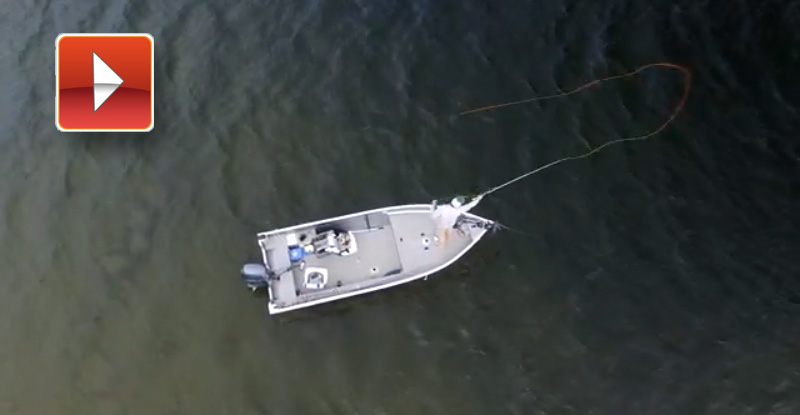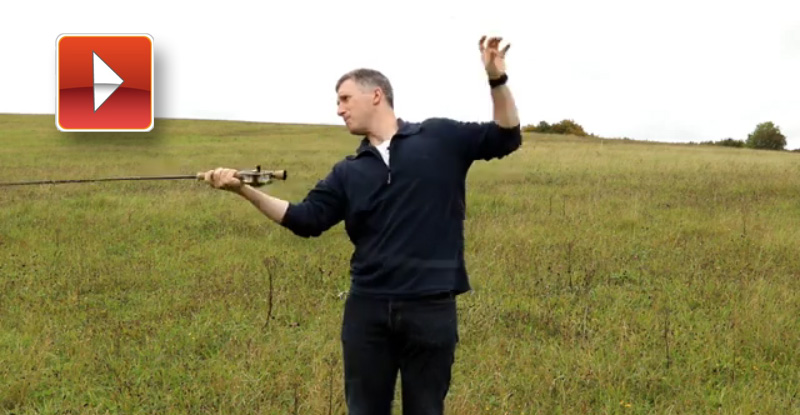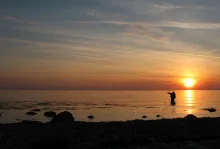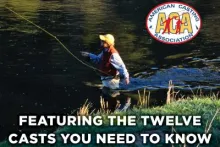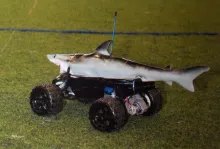There are a ton of situations where a backcast presentation will save the day. Here are a few good reasons to learn it – and how.
Most beginning fly fishers have enough trouble learning to cast forwards, and if you’re a beginner, the thought of casting backwards may seem pretty daunting. But it actually isn’t. If you can make an overhand cast forwards, you can also cast backwards. An overhand cast is essentially symmetrical, and the line movement behind you is much like that in front of you if you are making a normal, horizontal cast.
Casting backwards is in all simplicity just a question of letting go of the line in the backcast. If the line has the speed, it will shoot and stretch like it does in the forward cast.
If you double haul, you most likely do it on both the forward going and rearward going part of the cast, so again it’s a question of hauling on the rear cast and letting go. This type of cast is sometimes referred to as a backhand cast, a backcast presentation or simply a backcast.
So, that’s it. Simply let go of the line in the backcast.
More complicated than that
Well, of course it’s a little more complicated than that, and you can help yourself by doing a few things when casting backwards. In this article I assume that you are a right hand caster, but if you use the left hand, you can easily switch the directions in the description.
The most important step is to angle your body so that you can control the cast and see what’s going on. That means turning yourself so that the forward cast happens in front of you to the left (away from the direction you are casting), and the rearwards one happens just over your right shoulder (in the direction you want to cast).
Simply move your feet.
As a right hand caster, you will most likely stand with the left foot more forward and the right one to the rear, your body facing a little to the right in comparison the the casting direction, but your head turned to the left in comparison with the body - in order to see the forward cast. Like a boxer throwing a punch: the “good“ arm is further back than the one not punching.
A few casters stand with the feet perpendicular to the casting direction, their whole body facing the way they want to cast, but that’s actually not very efficient, unless you are casting very short casts.
In order to cast backwards, but still in the same general direction as you are casting now, you need to move your right foot to the front and the left one backwards, so that your body turns anticlockwise when seen from above – in other words you now face to the rear left in relation to the casting direction.
This will enable you to stretch your right arm in the direction of the cast and follow it. It also makes it possible for you to turn your head and see what’s going on in the direction that your fly is going. If you are sitting in a boat, turn your body the same way as much as you can in the seat.
Fishing lighter and shorter rods and using shorter casts, like when fishing on a small stream, you can even turn 90 degrees and have the line move from left to right, parallel to the front of your body. You won’t make extremely long casts in that position, but it can work. This gives you excellent control and a clear view of where your fly will land.
The reasons why
So, why would you want to cast backwards? There can be several reasons, but here are the situations where I have needed it:
Wind from the casting side
When fishing in windy conditions you sometimes come to a location where the wind blows right onto your casting arm. While it’s not impossible to conquer the wind and cast with the wind coming onto your rod and line, it’s very much easier to do it when the wind carries the line – and not least the fly – away from you and the rod. The wind can easily mess up the cast, and in the worst case scenario, the fly will hit you and hook you.
By literally turning and facing the other way, you suddenly get the wind to blow the fly and line away from you, and you can give it all you have without fearing getting a hook stuck in your clothes… or in your neck.
But you will now have to cast backwards to get the fly out.
Left handed/right handed
Of course you can – and most likely often will – choose your location so that the wind helps you rather than the opposite. I have fished with a left hand caster for many years – my good friend Henning – and I have had to join him on fishing spots that suited him, and had to cast backwards. He, being a left hand caster, has been forced to do so even more times, since the vast majority of our fishing friends use the right hand like I do. That has meant that Henning has had to cope with the bad wind direction many times. One of his solutions has always been to cast backwards.
Fishing from a boat
When fishing more than one person from a boat, one angler is typically positioned at the bow and the other at the aft. The boat is usually oriented so that the wind comes from the side, allowing your casts to go in the opposite direction.
If both anglers are right-handed, the one at the bow will usually cast with the rod outside the boat, while the angler at the aft will cast with the rod, line, and fly over the boat. Often, a guide or ghillie is situated in the middle, which can put them at risk of being hit by a fly.
A simple solution is for the angler at the rear of the boat to turn around, face into the wind, and cast backward. This allows for a lower and typically more efficient cast, and reduces the risk of hooking the person in the middle.
When fishing in the tropics, you will often have only one angler fishing at a time while the other rests and the guide positions the boat, preferably in such a way that the wind blows up along the boat from the rear, hitting the left shoulder of a right-hand caster. But as it is when fishing the ocean, fish move, and all of us who have been fishing the flats for bonefish, permit or tarpon will know that fish will very likely appear in "the wrong place", like to the right of the boat when all is set up for fish spotted to the left. A quick change to backhand casting can be what makes it possible to present a fly without endangering the people on the boat. In this case it will even be pretty common that you are fishing heavy gear and big flies, and it will be so much more important not to hit anybody.
Fish moving behind you
If you fish wading or from a boat, you will most likely have water all around you, and where there’s water, there might be fish.
Not rarely a fish will rise or show itself behind you, and being able to just lift the line off the water, making a single false cast or two and then place the fly in that direction, may be your key to hooking a fish, that would normally be hard to cast to because you’d have to reorient yourself and start a new cast so to say.
Same thing if you are fishing downstream and have to react quickly to something upstream. A slight turn of the upper body and a backwards flick of the rod might be what it takes to serve a fly to a fish that reveals itself “of of reach”.
A good investment
Like almost any casting skill, learning to cast backwards is a good investment. Being able to cope with odd conditions - wind, restricted room, sudden changes - is always going to be an advantage, and in some situations it might be what saves your day. A few hours on grass - or in the water - practicing this, will be worth your while.
- Log in to post comments


